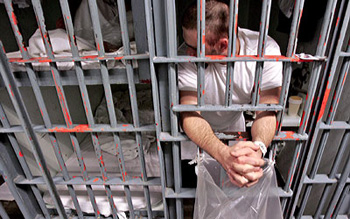Scores of inmates at Men's Central Jail have alleged serious physical abuse by deputies -- broken ribs, black eyes and head wounds that needed to be stapled shut, according to a report released by the American Civil Liberties Union Wednesday.

The extent of abuse at the downtown Los Angeles facility is impossible to gauge, the report said, because of the jail's lack of transparency. The ACLU, a longtime jail observer, said the Sheriff's Department refuses to share information on the number of investigated use-of-force incidents and their findings.
Sheriff's Department officials said all complaints are investigated thoroughly by the Office of Independent Review, which oversees the department.
"Use of force is a serious matter," said Sheriff's spokesman Steve Whitmore. "Whether these investigations are shared isn't relevant. What is relevant is the complaint itself is thoroughly investigated."
The ACLU report, spanning a 12-month period from 2008 to 2009, was based on weekly visits to the facility, and scores of inmate complaints. Many were anonymous, the report said, because inmates fear retribution from deputies. Complaints detailed direct assaults from deputies and prisoner attacks orchestrated by guards.
Whitmore denied that guards masterminded any prisoner attacks.
The civil rights advocacy group has long called for Men's Central Jail to be shut down, or have its inmate population significantly reduced. L.A. County Sheriff Lee Baca and others from the department have acknowledged deficiencies in the past, lobbying to open a more modern facility.
The department is seeking federal stimulus money to revamp the jail and replace it with a "high-tech facility," Whitmore said.
One complaint detailed in the report describes an inmate who alleged he was assaulted by about a dozen guards. They entered his cell and hit him with their flashlights repeatedly "like I was a baseball or something," the inmate told the ACLU. The inmate reported that he needed stitches but refused to visit the medical clinic because guards had intimidated him.
"I refused stitches. I refused a tetanus shot," the complaint read. "I refused everything."
The report suggested cutting down the number of inmates by releasing some inmates from the facility and monitoring them through electronic devices and drug and mental health programs.
Whitmore downplayed overcrowding at the facility, saying its capacity is 5,200 inmates with a current population of 4,175. In recent years, great improvements have been made, Whitmore said, especially so compared to decades ago when "inmates were sleeping on the roof."











